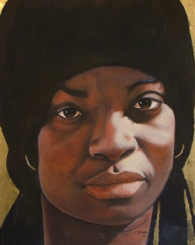
| HOME |
| NERVE |
| REVIEWS |
| ARCHIVE |
| EVENTS |
| LINKS |
| ABOUT US |
| CONTRIBUTORS |
| BACK ISSUES |
| CONTACT US |
 Joe Ankrah,
Mary Fitzpatrick
Joe Ankrah,
Mary Fitzpatrick
The Peoples Centre Gallery,
50-54 Mount Pleasant
17th August – 27th September 2007, Mon-Fri (9.30-16.30)
Reviewed by Desmond Fitzpatrick
Draw a picture of a man, someone famous someone you know, yes really. A mental picture if you’ve nothing to hand, head shoulders knees and toes, give him a hairstyle and a moustache.
What colour is he? White. I don’t know how it works either. Joe Ankrah, featured artist at The Peoples Centre Gallery blames Roy Rodgers. I don’t disagree, that cowboy has a lot to answer for but so has generations of race portrayal in our media.
Films, books, historical and biblical depictions of art in western society have typecast our heroes and villains. They’ve built dramas and situations in our head, which the memory draws on and deposits with little energy.
Now picture a celebration of real imagination on canvas and wood and sculpture, portraits which focus on subjects so natural that it takes a moment to realize that for so long they haven’t been naturally seen this way.
Sound impressive? I haven’t even said yet about the colourful carp, the fab four, the horses gallop or the tigers roar.
See Joe Ankrah’s exhibition for every time you sat through a “consolidate your loans advert”, or for every time you glimpsed a picture of Paris Hilton in the news or lazily watched a film you’d seen umpteen times. Take some control of your imagination and gaze in awe at his in this wonderful collection.
In her photographic collection Failaka, Mary Fitzpatrick shoots a landscape more than accustomed to the target practice. A war ravaged island civilisation left in a standstill and yet the presence of people remains.
Mary captures their last moments on film in a disturbing series of black and white stills, holding moments of violence and unrest out of space and time like the volcanic ash that solidified Pompeii. Some tourists pass me exclaiming “horrid, horrid,” “but another remarks “powerful stuff.”
And it is, and I hate the pathos it evokes like an Oxfam advertisement, the tragedy is used to manipulate the viewer’s response, you’re looking through someone else’s lens at someone else’s world, their tragedy. I feel tight in the throat and yet it’s so trite. I know it’s the steady hand pointing towards a blood speckled pillow or the keen eye focusing on a child’s discarded doll.
Yet after speaking to the artist, it became very apparent that my scepticism was my own and embarrassingly personal, I swallowed it along with the lump in my throat and talked about her personal journey and about the issues of abandonment strong themes within her collection.
Kuwait and Iraq and the first Gulf War were mentioned and as I moved to the political she returned to the personal and in the end I resolved to agree to disagree, mostly with myself. I took something away from her collection she never intended. Drawing comparisons between iconic and ironic messages some universal some personal. Horrid, horrid I thought, but powerful stuff.